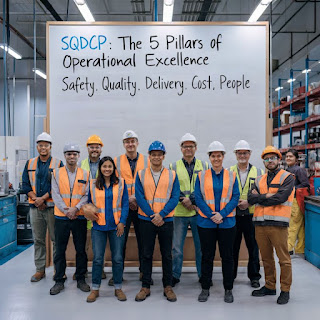New
Breaking operational barriers to peak productivity
October 4, 2024
The world needs more productivity growth. As a recent McKinsey Global Institute report argues, it’s the best possible antidote to wealth inequality, inflation, and exploding debt and could provide crucial funding for the net-zero transition and improved living standards.
Over the past few years, three primary vectors of operational improvement have promised to raise productivity, but companies have often struggled to take full advantage of the potential:
The technologies collectively referred to as 4IR (or Industry 4.0) can improve performance across an entire value chain. But McKinsey research indicates that only 30 percent of organizations successfully scale and sustain digital improvement.
In 2023, research from McKinsey Digital estimated that gen AI could add $2.6 trillion to $4.4 trillion to the global economy. But by 2024, only about 5 percent of organizations said they could attribute at least 5 percent of their EBIT to gen AI.
Core operational excellence practices have a proven track record of creating significant improvement across variables ranging from cost reduction to employee retention—with the effects increasing over time. But data from the Operational Excellence Survey (OES) indicate that few organizations perform well across all five elements (Exhibit 3). Those that do are far more likely to sustain impact from 4IR and gen AI: operational excellence increases the value that technologies can generate.

Pic. Source. https://www.linkedin.com/feed/update/urn:li:activity:7255912402729234432/
Excellence is Exceeding Customer Expectations.
Operational Excellence, is a broader methodology that aims to improve the overall performance of an organization by aligning all aspects of the business with the company's vision and strategy.
It emphasizes the importance of leadership, culture, and employee engagement to create and drive a culture of excellence and continuous improvement . Operational Excellence function can use all tools or techniques. Its aim is to bring the entire organization together to strive for excellence.
https://www.reliableplant.com/operational-excellence-31886
https://instituteopex.org/what-is-operational-excellence/
https://www.ibm.com/cloud/blog/delivering-value-through-operational-excellence
https://www.forbes.com/sites/forbestechcouncil/2022/12/20/understanding-operational-excellence-and-the-continuous-optimization-of-it-operational-efficiency/
Excellence is Exceeding Customer Expectations.
Consultants
Operational excellence looks beyond cost reduction and process improvements towards the achievement of long-term sustainable growth. It is a mindset that embraces certain principles and tools to create a culture of excellence within an organization. Operational excellence means every employee can see, deliver and improve the flow of value to a customer.
Operational Excellence
Business Improvement
The focus of Operational Excellence is a hybrid of cost containment, operational throughput and a stable work force. The objective is a management team who are equipped to operationalise business strategy, implement change in their organisation’s processes and systems, and maximise value over the life of the asset.
Deloitte’s Operational Excellence offerings assist Operational Executives to operationalise business strategy, implement improvement and change in their organisation’s processes, systems and people, as well as to maximise the value over the life of an asset or organisation. Operational Excellence includes:
- Environmental scanning & Strategic Context
- People, Performance and Culture
- Process Optimisation
- Supply Chain and Sourcing
- Asset Care
- Asset and Resource Optimisation
- Continuous Improvement
- Management Control Systems
- Organisational Redesign and Simplification
- System Capacity and Capability
- Social Labour Plan Commitments
Process Improvement Management - Process Productivity Management for Operational/Process Excellence - 3.6% Cost Reduction per Year
Companies
https://www.jpmorganchase.com/about/our-business/operational-excellence
27.10.2024
Sergio D'Amico, CSSBB
I talk about continuous improvement and organizational excellence to help small business owners create a workplace culture of profitability and growth.
26.10.2024
Operational Excellence is a system.0f 5 Pillars.
Here’s how the SQDCP five pillars can change your operations:
1️⃣ 𝗦𝗮𝗳𝗲𝘁𝘆:
- Unsafe conditions derail productivity and add costs.
- Focus on building a safe workspace, and watch efficiency rise.
2️⃣ 𝗤𝘂𝗮𝗹𝗶𝘁𝘆:
- Quality doesn’t cost; poor quality does.
- Set high standards and fix issues at the source.
3️⃣ 𝗗𝗲𝗹𝗶𝘃𝗲𝗿𝘆:
- Late delivery kills trust.
- Meet deadlines consistently to build client confidence.
4️⃣ 𝗖𝗼𝘀𝘁:
- Cost control isn’t about cutting, it's about using resources wisely. (Productivity of Resources - Industrial Engineering)
- Streamline processes to reduce waste, not quality.
5️⃣ 𝗣𝗲𝗼𝗽𝗹𝗲:
- People drive change; machines don’t.
- Train, motivate, and listen to your team. They’re the backbone of excellence.
Comment by Jim Beckham
Retired Director, Total Quality Management at JTEKT Corporation
I find the comments on priority an interesting discussion point. Let me contribute from someone who worked 14 years at one of the Toyota group of companies. We only used the first four, in priority sequence, SQDC. But it’s important to understand which stakeholder is impacted by each:
Safety- Employee stakeholder;
Quality - Customer stakeholder;
Delivery - Customer stakeholder; and
Cost - Shareholder stakeholder.
When management, an improvement team or a QC Circle follows the 8-Step Problem Solving method to make an improvement to one of these four areas, the solution for the improvement can not adversely impact the areas above. For example it a team was trying to improve productivity (Cost) and the improvement would make it more dangerous for the workers, or create a quality defect, or impact delivery, then the team would have to find another solution.
Additional Comment by Jim Beckham, Retired Director, Total Quality Management at JTEKT Corporation
Just to be clear, an improvement could be made that adversely impacts an area below and that would ok. For example, when fixing a Quality problem the solution can’t adversely impact Safety (which is above), but it could adversely impact Cost or Delivery (which are below). This is ok. It then gives the improvement team motivation to then solve the secondary Cost or Delivery problem. A little pain is always a good motivator for teams to take ownership and to improve.
Ud. 25.1.2025, 27.10.2024
Pub. 26.1.2023

No comments:
Post a Comment